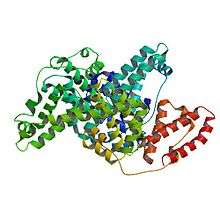Bovine serum albumin
| albumin | |
|---|---|
 | |
| Identifiers | |
| Organism | |
| Symbol | ALB |
| Entrez | 280717 |
| HomoloGene | 105925 |
| RefSeq (mRNA) | NM_180992 |
| RefSeq (Prot) | NP_851335 |
| UniProt | P02769 |
| Other data | |
| Chromosome | 6: 91.54 - 91.57 Mb |
Bovine serum albumin (also known as BSA or "Fraction V") is a serum albumin protein derived from cows. It is often used as a protein concentration standard in lab experiments.
The nickname "Fraction V" refers to albumin being the fifth fraction of the original Edwin Cohn purification methodology that made use of differential solubility characteristics of plasma proteins. By manipulating solvent concentrations, pH, salt levels, and temperature, Cohn was able to pull out successive "fractions" of blood plasma. The process was first commercialized with human albumin for medical use and later adopted for production of BSA.

Properties
The full-length BSA precursor protein is 607 amino acids (AAs) in length. An N-terminal 18-residue signal peptide is cut off from the precursor protein upon secretion, hence the initial protein product contains 589 amino acid residues. An additional four amino acids are cleaved to yield the mature BSA protein that contains 583 amino acids.
| Peptide | Position | Length (AAs) | MW Da |
|---|---|---|---|
| Full length precursor | 1 – 607 | 607 | 69,324 |
| Signal peptide | 1 – 18 | 18 | 2,107 |
| Propeptide | 19 – 22 | 4 | 478 |
| Mature protein | 25 – 607 | 583 | 66,463 |
Physical properties of BSA:
- Number of amino acid residues: 583
- Molecular weight: 66,463 Da (= 66.5 kDa)
- isoelectric point in water at 25 °C: 4.7[1]
- Extinction coefficient of 43,824 M−1cm−1 at 279 nm[2]
- Dimensions: 140 × 40 × 40 Å (prolate ellipsoid where a = b < c)[3]
- pH of 1% Solution: 5.2-7 [4][5]
- Optical Rotation: [α]259: -61°; [α]264: -63°[4][5]
- Stokes Radius (rs): 3.48 nm[6]
- Sedimentation constant, S20,W × 1013: 4.5 (monomer), 6.7 (dimer)[4][5]
- Diffusion constant, D20,W × 10−7 cm2/s: 5.9[4][5]
- Partial specific volume, V20: 0.733[4][5]
- Intrinsic viscosity, η: 0.0413[4][5]
- Frictional ratio, f/f0: 1.30[4][5]
- Refractive index increment (578 nm) × 10−3: 1.90[4][5]
- Optical absorbance, A279 nm1 g/L: 0.667[4][5]
- Mean residue rotation, [m']233: 8443[4][5]
- Mean residue ellipticity: 21.1 [θ]209 nm; 20.1 [θ]222 nm[4][5]
- Estimated a-helix, %: 54[4][5]
- Estimated b-form, %: 18[4][5]
Applications
BSA has numerous biochemical applications including ELISAs (Enzyme-Linked Immunosorbent Assay), immunoblots, and immunohistochemistry. It is also used as a nutrient in cell and microbial culture. In restriction digests, BSA is used to stabilize some enzymes during the digestion of DNA and to prevent adhesion of the enzyme to reaction tubes, pipet tips, and other vessels.[7] This protein does not affect other enzymes that do not need it for stabilization. BSA is also commonly used to determine the quantity of other proteins, by comparing an unknown quantity of protein to known amounts of BSA (see Bradford protein assay). BSA is used because of its ability to increase signal in assays, its lack of effect in many biochemical reactions, and its low cost, since large quantities of it can be readily purified from bovine blood, a byproduct of the cattle industry.
See also
References
- ↑ Ge S, Kojio K, Takahara A, Kajiyama T (1998). "Bovine serum albumin adsorption onto immobilized organotrichlorosilane surface: influence of the phase separation on protein adsorption patterns". Journal of Biomaterials Science. Polymer Edition. 9 (2): 131–50. doi:10.1163/156856298x00479. PMID 9493841.
- ↑ Peters T (1975). Putman FW, ed. The Plasma Proteins. Academic Press. pp. 133–181.
- ↑ Wright AK, Thompson MR (Feb 1975). "Hydrodynamic structure of bovine serum albumin determined by transient electric birefringence". Biophysical Journal. 15 (2 Pt 1): 137–41. doi:10.1016/S0006-3495(75)85797-3. PMC 1334600
 . PMID 1167468.
. PMID 1167468. - 1 2 3 4 5 6 7 8 9 10 11 12 13 Putnam FW (1975). The Plasma Proteins: Structure, Function and Genetic Control. 1 (2nd ed.). New York: Academic Press. pp. 141, 147. ASIN B007ESU1JQ.
- 1 2 3 4 5 6 7 8 9 10 11 12 13 "Albumin from bovine serum" (PDF). Sigma-Aldrich. Retrieved 5 July 2013.
- ↑ Axelsson I (May 1978). "Characterization of proteins and other macromolecules by agarose gel chromatography". Journal of Chromatography A. 152 (1): 21–32. doi:10.1016/S0021-9673(00)85330-3.
- ↑ "BSA FAQ". Invitrogen. Retrieved 19 January 2012.
Further reading
- Hirayama K, Akashi S, Furuya M, Fukuhara K (Dec 1990). "Rapid confirmation and revision of the primary structure of bovine serum albumin by ESIMS and Frit-FAB LC/MS". Biochemical and Biophysical Research Communications. 173 (2): 639–46. doi:10.1016/S0006-291X(05)80083-X. PMID 2260975.
- Zhang M, Desai T, Ferrari M (May 1998). "Proteins and cells on PEG immobilized silicon surfaces" (PDF). Biomaterials. 19 (10): 953–60. doi:10.1016/S0142-9612(98)00026-X. PMID 9690837.
- Wise SA, Watters RL (2010-06-30). "Bovine Serum Albumin (7 % Solution)" (pdf). Certificate of Analysis. United States National Institute of Standards & Technology. Retrieved 2011-12-22.
External links
- Serum Albumin, Bovine at the US National Library of Medicine Medical Subject Headings (MeSH)